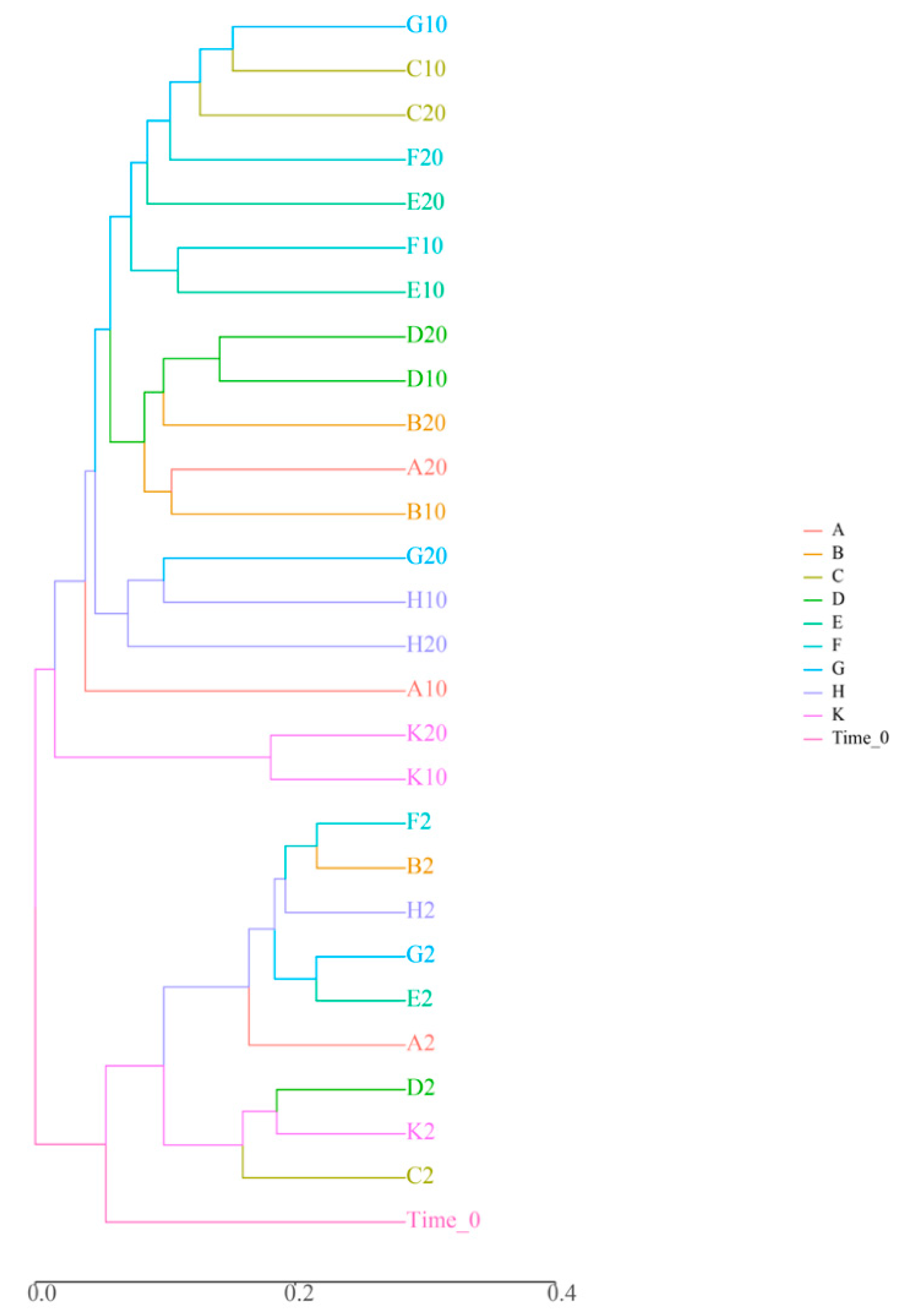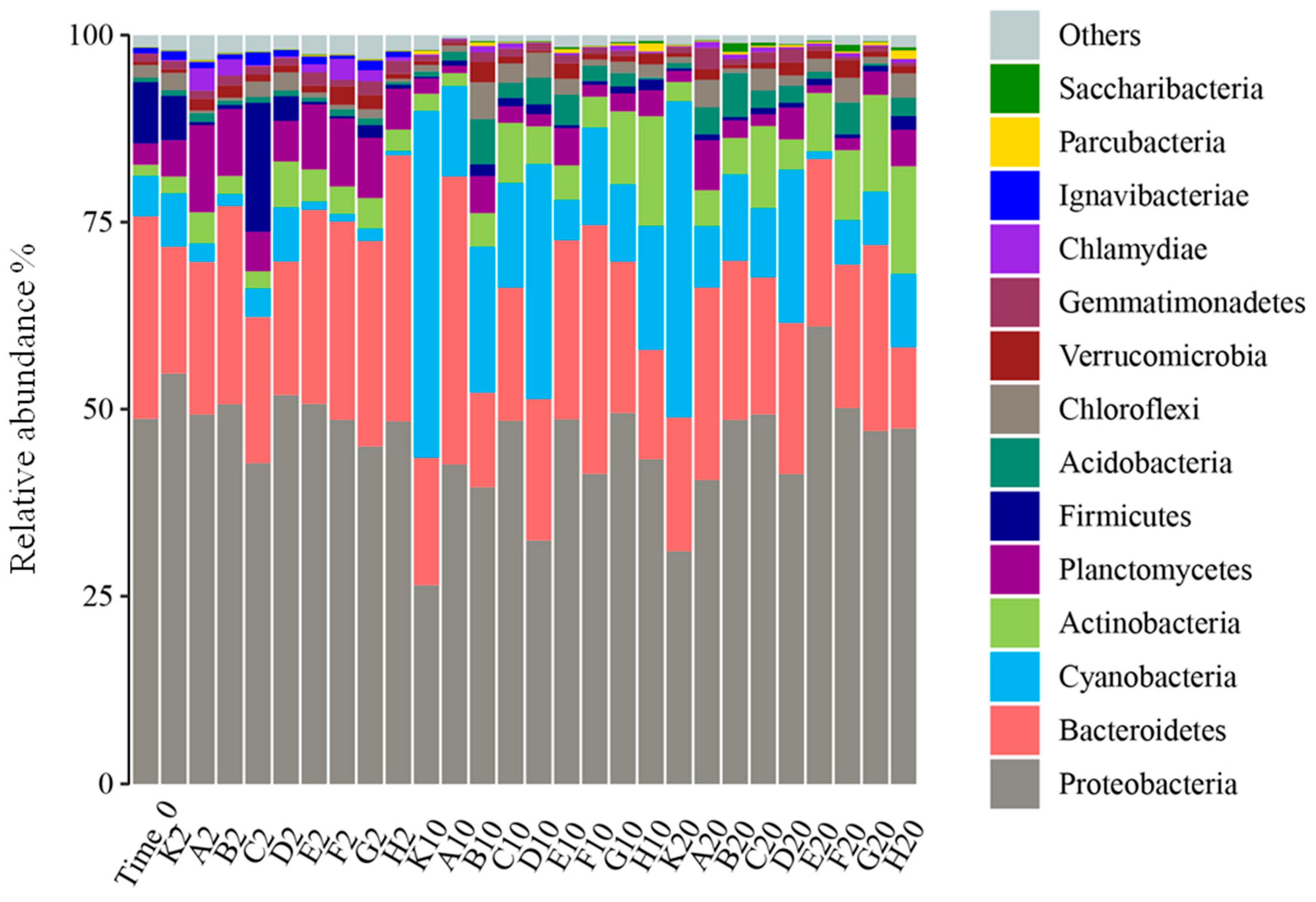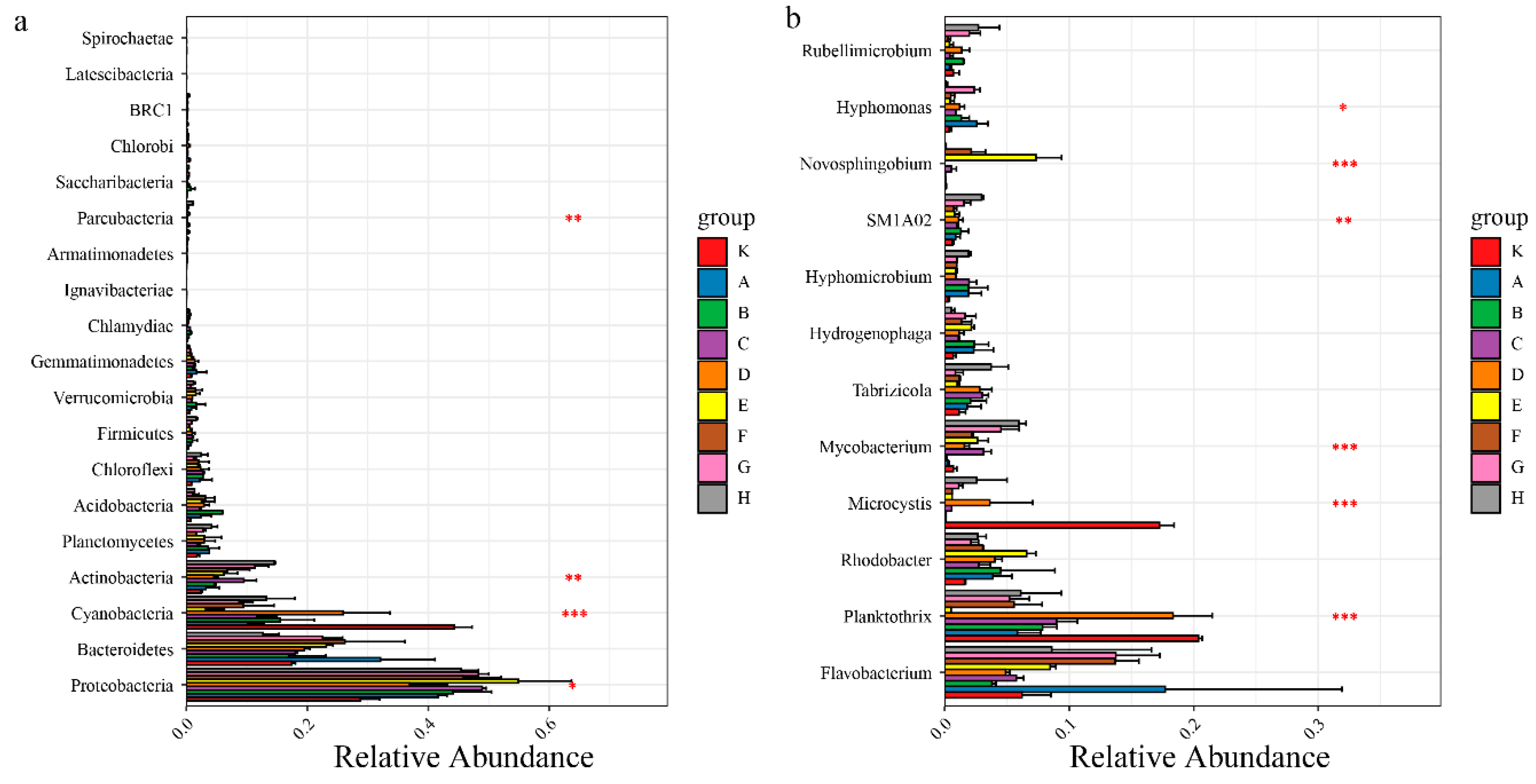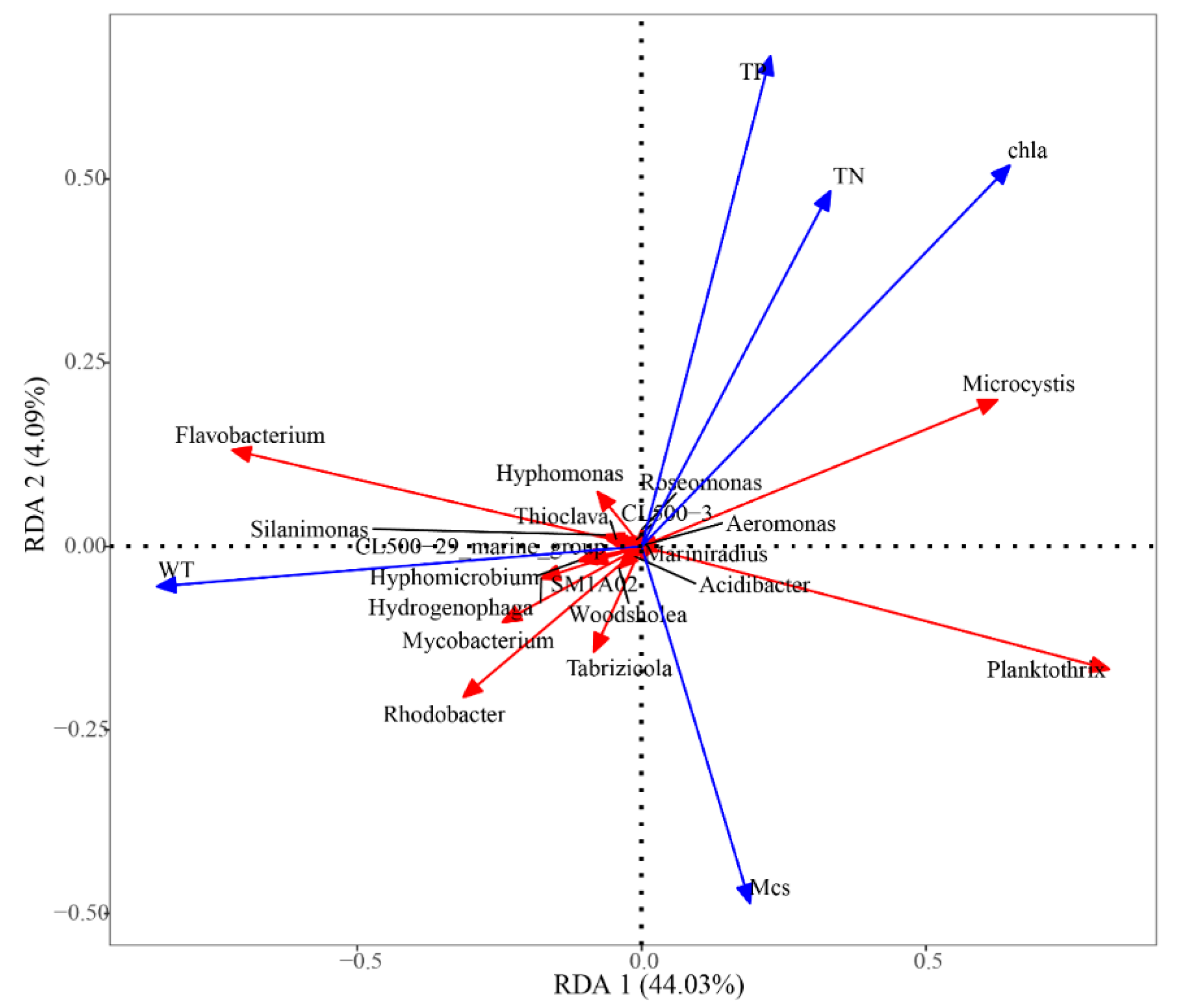D. magna in Combination with M. aquaticum Inhibited the Bacterioplankton in Eutrophic Water
Abstract
1. Introduction
2. Materials and Methods
2.1. Source of Original Materials for Testing
2.2. Experiment Design
2.3. Collection and Determination of Samples
2.3.1. Collection of Samples
2.3.2. Community Structure of Planktonic Bacteria
2.4. Data Analysis and Processing
2.4.1. Chlorophyll a (Chla) and Microcystin (MC) Measurement
2.4.2. Operational Taxonomy Units (OTUs) Taxonomic and Microbial Diversity Analysis
2.4.3. Statistical Analysis
3. Results
3.1. Influence of “Submerged Macrophytes—D. magna” Combination on Planktonic Bacteria Diversity
3.2. Influence of “Submerged Macrophytes—D. magna” Combination on Planktonic Bacterial Community Structure
3.3. Relationships between Water Environmental Factors and the Planktonic Bacterial Community during “Submerged Macrophytes—D. magna” Combined Remediation
4. Discussion
4.1. Effects of D. magna on Bacterioplankton in Eutrophic Water
4.2. Effects of Submerged Macrophytes on Bacterioplankton in Eutrophic Water
4.3. Combined Effects of Submerged Macrophytes and D. magna on Bacterioplankton in Eutrophic Water
4.4. Relationships between Environmental Factors and Bacterioplankton
4.5. Application Prospects
5. Conclusions
Supplementary Materials
Author Contributions
Funding
Acknowledgments
Conflicts of Interest
References
- Hernández-Crespo, C.; Oliver, N.; Bixquert, J.; Gargallo, S.; Martin, M.A. Comparison of three plants in a surface flow constructed wetland treating eutrophic water in a Mediterranean climate. Hydrobiologia 2016, 774, 183–192. [Google Scholar] [CrossRef]
- Wojciech, K.; Joanna, K. Variations in zooplankton functional groups density in freshwater ecosystems exposed to cyanobacterial blooms. Sci. Total Environ. 2020, 730, 139044. [Google Scholar]
- Le, C.; Zha, Y.; Li, Y.; Sun, D.; Lu, H.; Yin, B. Eutrophication of Lake Waters in China: Cost, Causes, and Control. Environ. Manag. 2010, 45, 662–668. [Google Scholar] [CrossRef] [PubMed]
- Bing, X.W.; Chen, J.Z. The control of eutrophic water in ponds byfloating-bed soilless culture of plants. J. Zhan-Jiang Ocean Univ. 2001, 21, 29–33. (In Chinese) [Google Scholar]
- Smith, V.H. Eutrophication of freshwater and coastal marine ecosystems a global problem. Environ. Sci. Pollut. Res. 2003, 10, 126–139. [Google Scholar] [CrossRef] [PubMed]
- Gerke, M.; Hübner, D.; Schneider, J.; Winkelmann, C. Can top-down effects of cypriniform fish be used to mitigate eutrophication effects in medium-sized European rivers? Sci. Total Environ. 2021, 755, 142547. [Google Scholar] [CrossRef]
- Waajen, G.; Van Oosterhout, F.; Douglas, G.; Lürling, M. Management of eutrophication in lake de kuil (the Netherlands) using combined flocculant—Lanthanum modified bentonite treatment. Water Res. 2016, 97, 83–95. [Google Scholar] [CrossRef]
- Triest, L.; Stiers, I.; Van Onsem, S. Biomanipulation as a nature-based solution to reduce cyanobacterial blooms. Aquat. Ecol. 2016, 50, 461–483. [Google Scholar] [CrossRef]
- Shen, R.; Gu, X.; Chen, H.; Mao, Z.; Zeng, Q.; Jeppesen, E. Combining bivalve (Corbicula fluminea) and filter-feeding fish (Aristichthys nobilis) enhances the bioremediation effect of algae: An outdoor mesocosm study. Sci. Total Environ. 2020, 727, 138692. [Google Scholar] [CrossRef]
- Søndergaard, M.; Liboriussen, L.; Pedersen, A.R.; Jeppesen, E. Lake Restoration by Fish Removal: Short- and Long-Term Effects in 36 Danish Lakes. Ecosystems 2008, 11, 1291–1305. [Google Scholar] [CrossRef]
- Bakker, E.S.; Sarneel, J.M.; Gulati, R.D.; Liu, Z.; Van Donk, E. Restoring macrophyte diversity in shallow temperate lakes: Biotic versus abiotic constraints. Hydrobiologia 2012, 710, 23–37. [Google Scholar] [CrossRef]
- Skov, C.; Nilsson, P.A. Evaluating stocking of YOY pike Esox lucius as a tool in the restoration of shallow lakes. Freshw. Biol. 2007, 52, 1834–1845. [Google Scholar] [CrossRef]
- Wojtal-Frankiewicz, A.; Frankiewicz, P. The impact of pelagic (Daphnia longispina) and benthic (Dreissena polymorpha) filter feeders on chlorophyll and nutrient concentration. Limnol.-Ecol. Manag. Inland Waters 2011, 41, 191–200. [Google Scholar] [CrossRef]
- Chen, Z.; Zhao, D.; Li, M.; Tu, W.; Luo, X.; Liu, X. A field study on the effects of combined biomanipulation on the water quality of a eutrophic lake. Environ. Pollut. 2020, 265, 115091. [Google Scholar] [CrossRef] [PubMed]
- Montemezzani, V.; Duggan, I.C.; Hogg, I.D.; Craggs, R.J. A review of potential methods for zooplankton control in wastewater treatment High Rate Algal Ponds and algal production raceways. Algal Res. 2015, 11, 211–226. [Google Scholar] [CrossRef]
- Van Gremberghe, I.; Vanormelingen, P.; Van der Gucht, K.; Mancheva, A.; D’hondt, S.; De Meester, L.; Vyverman, W. Influence of Daphniainfo chemicals on functional traits of Microcystisstrains (Cyanobacteria). Hydrobiologia 2009, 635, 147–155. [Google Scholar] [CrossRef]
- Chislock, M.F.; Sarnelle, O.; Jernigan, L.M.; Wilson, A.E. Do high concentrations of microcystin prevent Daphnia control of phytoplankton? Water Res. 2013, 47, 1961–1970. [Google Scholar] [CrossRef]
- Lyu, K.; Guan, H.; Wu, C.; Wang, X.; Wilson, A.E.; Yang, Z. Maternal consumption of non-toxic microcystis by daphnia magna induces tolerance to toxic microcystis in offspring. Freshw. Biol. 2016, 61, 219–228. [Google Scholar] [CrossRef]
- Zeng, L.; He, F.; Dai, Z.; Xu, D.; Liu, B.; Zhou, Q.; Wu, Z. Effect of submerged macrophyte restoration on improving aquatic ecosystem in a subtropical, shallow lake. Ecol. Eng. 2017, 106, 578–587. [Google Scholar] [CrossRef]
- Yasin, H.; Usman, M.; Rashid, H.; Nasir, A.; Randhawa, I.A. Alternative approaches for solid waste management a case study in faisalabad pakistan. Earth Sci. Pak. 2017, 1, 7. [Google Scholar] [CrossRef]
- Li, Q.; Gu, P.; Zhang, H.; Luo, X.; Zhang, J.; Zheng, Z. Response of submerged macrophytes and leaf biofilms to the decline phase of Microcystis aeruginosa: Antioxidant response, ultrastructure, microbial properties, and potential mechanism. Sci. Total Environ. 2020, 699, 134325. [Google Scholar] [CrossRef] [PubMed]
- Nakai, S.; Yamada, S.; Hosomi, M. Anti-cyanobacterial fatty acids released from Myriophyllum spicatum. Hydrobiologia 2005, 543, 71–78. [Google Scholar] [CrossRef]
- Quast, C.; Pruesse, E.; Yilmaz, P.; Gerken, J.; Schweer, T.; Yarza, P.; Peplies, J.; Glöckner, F.O. The SILVA ribosomal RNA gene database project: Improved data processing and web-based tools. Nucleic Acids Res. 2012, 41, D590–D596. [Google Scholar] [CrossRef] [PubMed]
- Wang, Q.; Garrity, G.M.; Tiedje, J.M.; Cole, J.R. Naive Bayesian classifier for rapid assignment of rRNA sequences into the new bacterial taxonomy. Appl. Environ. Microbiol. 2007, 73, 5261–5267. [Google Scholar] [CrossRef]
- Hochmuth, J.D.; Schamphelaere, K.A.C.D. The effect of temperature on the sensitivity ofDaphnia magnato cyanobacteria is genus dependent. Environ. Toxicol. Chem. 2014, 33, 2333–2343. [Google Scholar] [CrossRef]
- Lin, S.; Wu, Z.; Yu, G.; Zhu, M.; Yu, B.; Li, R. Genetic diversity and molecular phylogeny of Planktothrix (Oscillatoriales, cyanobacteria) strains from China. Harmful Algae 2010, 9, 87–97. [Google Scholar] [CrossRef]
- Asselman, J.; Hochmuth, J.; De Schamphelaere, K. A comparison of the sensitivities of Daphnia magna and Daphnia pulex to six different cyanobacteria. Harmful Algae 2014, 39, 1–7. [Google Scholar] [CrossRef]
- Liu, Z.; Huang, S.; Sun, G.; Xu, Z.; Xu, M. Phylogenetic diversity, composition and distribution of bacterioplankton community in the Dongjiang River, China. FEMS Microbiol. Ecol. 2012, 80, 30–44. [Google Scholar] [CrossRef]
- Zhang, Z.; Chen, H.; Mu, X.; Zhang, S.; Pang, S.; Ohore, O.E. Nitrate application decreased microbial biodiversity but stimulated denitrifiers in epiphytic biofilms on Ceratophyllum demersum. J. Environ. Manag. 2020, 269, 110814. [Google Scholar] [CrossRef]
- Nagengast, B.; Gąbka, M. Apparent niche partitioning of two congeneric submerged macrophytes in small water bodies: The case of Ceratophyllum demersum L. and C. submersum L. Aquat. Bot. 2017, 137, 1–8. [Google Scholar] [CrossRef]
- Haukka, K.; Heikkinen, E.; Kairesalo, T.; Karjalainen, H.; Sivonen, K. Effect of humic material on the bacterioplankton community composition in boreal lakes and mesocosms. Environ. Microbiol. 2005, 7, 620–630. [Google Scholar] [CrossRef] [PubMed]
- Burks, R.L.; Lodge, D.M.; Jeppesen, E.; Lauridsen, T.L. Diel horizontal migration of zooplankton: Costs and benefits of inhabiting the littoral. Freshw. Biol. 2002, 47, 343–365. [Google Scholar] [CrossRef]
- Huo, Y.; He, W.-H.; Luo, K.; Wang, Y.-Y.; Zhang, Y.-J.; Tian, Q.-T.; He, P. Bioremediation efficiency of applying Daphnia magna and submerged plants: A case study in Dishui Lake of Shanghai, China. Chin. J. Appl. Ecol. 2010, 21, 495–499. [Google Scholar]
- Kim, S.-R.; Woo, S.-S.; Cheong, E.-H.; Ahn, T.-S. Nutrient removal from sewage by an artificial food web system composed of phytoplankton and Daphnia magna. Ecol. Eng. 2003, 21, 249–258. [Google Scholar] [CrossRef]
- Brakstad, O.G.; Bonaunet, K. Biodegradation of Petroleum Hydrocarbons in Seawater at Low Temperatures (0–5 °C). Biodegradation 2006, 17, 71–82. [Google Scholar] [CrossRef]
- Zhu, T.; Cao, T.; Ni, L.; He, L.; Yi, C.; Yuan, C.; Xie, P. Improvement of water quality by sediment capping and re-vegetation with Vallisneria natans L.: A short-term investigation using an in situ enclosure experiment in Lake Erhai, China. Ecol. Eng. 2016, 86, 113–119. [Google Scholar] [CrossRef]
- Zheng, Y.K.; Liu, K.; Xiong, Z.J.; Miao, C.P.; Chen, Y.W.; Li-Hua, X.U.; Zhao, L.X. Effect of large-scale planting water hyacinth on cultivable bacterial community structure in the eutrophic lake. Microbiol. China 2015, 42, 42–53. (In Chinese) [Google Scholar]
- Bai, S.J.; Huang, L.P.; Su, J.Q.; Tian, Y.; Zheng, T.L. Algicidal Effects of a Novel Marine Actinomycete on the Toxic Dinoflagellate Alexandrium tamarense. Curr. Microbiol. 2011, 62, 1774–1781. [Google Scholar] [CrossRef]
- Yuan, P.; Xu, L.K.; Ke, B.L.; Sun, F.; Gao, H.J. Treatment and ecological restoration of black and odorous water body in Yueya Lake in Nanjing City. J. Environ. Eng. Technol. 2020, 10, 696–701. (In Chinese) [Google Scholar]




| Treatments | Daphnia magna | Ceratophyllum demersum | Myriophyllum spicatum | |
|---|---|---|---|---|
| K (control) | / | / | / | |
| Daphnia magna | A | 25 ind L−1 | / | / |
| B | 100 ind L−1 | / | / | |
| Submerged macrophytes | C | / | 3 g L−1 | / |
| D | / | / | 3 g L−1 | |
| Submerged macrophyte + Daphnia magna | E | 25 ind L−1 | 3 g L−1 | / |
| F | 100 ind L−1 | 3 g L−1 | / | |
| G | 25 ind L−1 | / | 3 g L−1 | |
| H | 100 ind L−1 | / | 3 g L−1 | |
| Treatment | Coverage | Shannon | Simpson | Chao | Treatment | Coverage | Shannon | Simpson | Chao | Treatment | Coverage | Shannon | Simpson | Chao |
|---|---|---|---|---|---|---|---|---|---|---|---|---|---|---|
| K2 | 0.988 | 5.28 | 0.0145 | 1246 | K10 | 0.989 | 4.40 | 0.0595 | 1053 | K20 | 0.987 | 4.36 | 0.0659 | 1175 |
| A2 | 0.988 | 5.32 | 0.0140 | 1249 | A10 | 0.989 | 4.27 | 0.0718 | 1037 | A20 | 0.991 | 5.25 | 0.0101 | 973 |
| B2 | 0.989 | 5.09 | 0.0224 | 1174 | B10 | 0.990 | 5.35 | 0.0110 | 1097 | B20 | 0.991 | 4.87 | 0.0169 | 914 |
| C2 | 0.989 | 5.04 | 0.0280 | 1184 | C10 | 0.987 | 5.37 | 0.0107 | 1255 | C20 | 0.991 | 5.57 | 0.0080 | 1082 |
| D2 | 0.988 | 5.42 | 0.0123 | 1320 | D10 | 0.990 | 4.40 | 0.0558 | 944 | D20 | 0.990 | 4.78 | 0.0322 | 1042 |
| E2 | 0.988 | 5.20 | 0.0196 | 1240 | E10 | 0.990 | 5.49 | 0.0111 | 1171 | E20 | 0.989 | 5.06 | 0.0158 | 1108 |
| F2 | 0.988 | 4.99 | 0.0262 | 1219 | F10 | 0.988 | 4.82 | 0.0542 | 1165 | F20 | 0.990 | 5.39 | 0.0130 | 1140 |
| G2 | 0.987 | 5.32 | 0.0166 | 1343 | G10 | 0.988 | 5.34 | 0.0128 | 1258 | G20 | 0.989 | 4.79 | 0.0231 | 1070 |
| H2 | 0.989 | 4.81 | 0.0422 | 1151 | H10 | 0.987 | 4.14 | 0.0860 | 1156 | H20 | 0.988 | 5.25 | 0.0114 | 1135 |
Publisher’s Note: MDPI stays neutral with regard to jurisdictional claims in published maps and institutional affiliations. |
© 2020 by the authors. Licensee MDPI, Basel, Switzerland. This article is an open access article distributed under the terms and conditions of the Creative Commons Attribution (CC BY) license (http://creativecommons.org/licenses/by/4.0/).
Share and Cite
Yang, B.; Wei, X.; Wang, H.; Li, J.; Zheng, X.; Zhang, C.; Li, B. D. magna in Combination with M. aquaticum Inhibited the Bacterioplankton in Eutrophic Water. Sustainability 2020, 12, 9548. https://doi.org/10.3390/su12229548
Yang B, Wei X, Wang H, Li J, Zheng X, Zhang C, Li B. D. magna in Combination with M. aquaticum Inhibited the Bacterioplankton in Eutrophic Water. Sustainability. 2020; 12(22):9548. https://doi.org/10.3390/su12229548
Chicago/Turabian StyleYang, Bo, Xiaocheng Wei, Hanyang Wang, Jiarui Li, Xiangqun Zheng, Chunxue Zhang, and Bo Li. 2020. "D. magna in Combination with M. aquaticum Inhibited the Bacterioplankton in Eutrophic Water" Sustainability 12, no. 22: 9548. https://doi.org/10.3390/su12229548
APA StyleYang, B., Wei, X., Wang, H., Li, J., Zheng, X., Zhang, C., & Li, B. (2020). D. magna in Combination with M. aquaticum Inhibited the Bacterioplankton in Eutrophic Water. Sustainability, 12(22), 9548. https://doi.org/10.3390/su12229548





